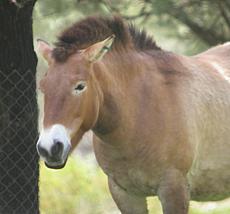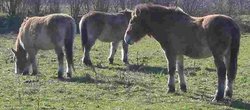Przewalski's Horse
|
|
| Przewalski's Horse Conservation status: Extinct in the wild | ||||||||||||||
|---|---|---|---|---|---|---|---|---|---|---|---|---|---|---|
 | ||||||||||||||
| Scientific classification | ||||||||||||||
| ||||||||||||||
| Binomial name | ||||||||||||||
| Equus przewalskii |
Przewalski's Horse (Equus przewalskii or E. caballus przewalskii), pronounced "(p)she-VAHL-skeez horse", also known as the Mongolian Wild Horse, or Takhi, is the closest living relative of the Domestic Horse and may in fact be the same species. (Authorities differ about the correct classification.) The two are the only equids that can cross-breed and produce fertile offspring.
As of 2002, the world population of these horses is about 1000, all descended from approximately 15 captured around 1900 and bred in zoos.
History
The horse is named after Russian General Nikolaï Mikhaïlovitch Prjevalski (1839–1888) who was also an explorer and naturalist. (The spelling "Przewalski" is actually Polish.) He described the horse in 1881, after having gone on an expedition to find it, based on rumours of its existence. Many horses were captured in around 1900 and placed in zoos, of these about twelve to fifteen bred and formed today's population.
The population declined in the 20th century due to a combination of factors, and the wild population in Mongolia died out in the 1960s - the last herd was sighted in 1967 and the last individual horse in 1969. Expeditions after this failed to find any.
In 1977 the 'Foundation for the Preservation and Protection of the Przewalski Horse' was founded, which started a program of exchange between the captive populations to reduce inbreeding, later starting a breeding program of its own. In 1992, the Foundation released sixteen horses into the wild in Mongolia, followed by further batches later on. The introduced horses have been breeding succesfully.
The area to which they have been reintroduced became Hustai National Park in 1998.
Three of these horses now graze in a 12 acre (49,000 m²) paddock in the Clocaenog Forest in North Wales, UK, on the site of a former Neolithic/Iron Age settlement. The Forestry Commission hopes they will help recreate scenes from the Iron Age when these horses first roamed free in the woods.
Appearance and behaviour
Przewalski's Horse is stockily built in comparison to domesticated horses, with shorter legs. Typical length is about 2.1 metres (7 feet) with a 90 cm (3 foot) tail. They weigh around 350 kilograms (770 lb). The coat varies from dark brown around the mane (which stands erect) to pale brown on the flanks and yellowish-white on the belly.
In the wild, Przewalski's Horses live in social groups consisting of a dominant male, several mares, and their offspring. Each group has a well-defined home range; within the range, the herd travels between three and six miles a day, spending time grazing, drinking, using salt licks, dozing, and taking mud baths. At night, the herd clusters and sleeps for about four hours.
Fillies leave their natal groups around age 2, and look for a herd to join, after which they will begin to breed. Colts are driven out when they are about three years old, and spend a year or two in small bachelor herds, practicing fighting. At around age 5, a stallion will try to pass on his genes by attempting to take over an existing herd, stealing one or more mares from another stallion's harem, or gathering unattached fillies.
External links
- Details of the re-introduction program for Przewalski's horse. (http://www.treemail.nl/takh/index.htm)
- Details of the history and captive breeding program for Przewalski's Horse. (http://www.imh.org/imh/bw/prz.html)bg:Кон на Пржевалски
da:Przewalski-hest de:Przewalski-Pferd et:Prževalski hobune fr:Cheval de Prjevalski nl:Przewalskipaard pl:Koń Przewalskiego ru:Лошадь Пржевальского sv:Przjevalskijs häst zh:野马

